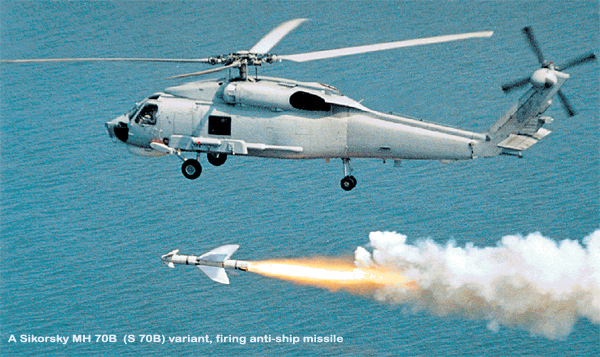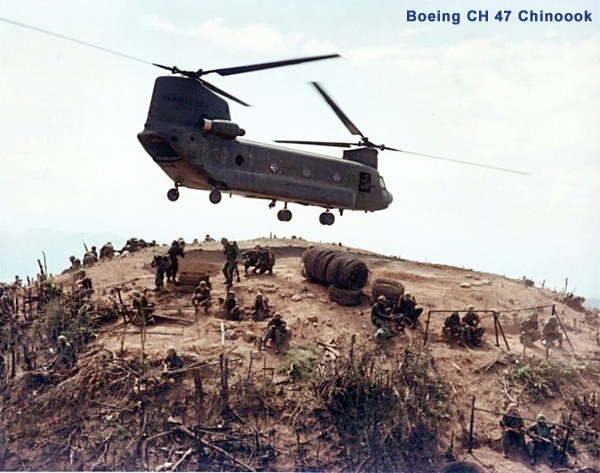|
However these can also be modified or converted
to perform other combat related tasks or even
armed with weapons for supporting ground troops.
Specialised military helicopters like the attack,
surveillance and observation and anti submarine
warfare are required for conduct of specific tasks/missions.
Military helicopters are an integral part of
the land, sea and air operations of modern armies
including their ever increasing employment in
sub conventional conflicts (counter insurgency
and counter terrorist operations) the world over.
A typical military helicopter force should have
all class of helicopters ranging from light observation
to utility/lift (light, medium and heavy) including
attack/armed helicopters to cater for the operational
requirements of their respective armed forces.
Military Helicopters
The operational diversities of the Indian Armed
Forces coupled with extremity and variety of terrain
(from sea level to high altitude) underline the
need for state of the art, modern technology helicopters
capable of operating both by day and night in
a complex battlefield environment of future.
The weakest Link in the Indian Military inventory
is the lack of specialized helicopters for attack
and anti submarine warfare for the Army/ IAF and
Navy respectively. Attack helicopters have so
far been with IAF but from now, newer assets should
go to the Army which is strengtheing its Army
Aviation Corps.
As per reports, the Indian armed forces are
looking to induct as many as 900 to 1000 helicopters
in the coming decade ranging from attack and high
altitude reconnaissance to medium lift and VVIP
variants (presently under the MOD scanner), with
some of these projects in the final stages of
the acquisition process.
Presently the Indian military holds in its kitty
approximately 600 helicopters of various types
and class including specialized ones, but sadly,
the majority of these have far exceeded their
life span and are either obsolete or nearing obsolescence.
Their total numbers in any case are still scanty,
much lower than even what our western neighbour
has.

The light observation helicopters (Chetak and
Cheetah) used by the Army, Navy and Air Force
are vintage and need urgent and immediate replacement.
The trials for their replacement (Army &
Air Force) were completed a year back but the
MOD is yet to take a decision on this project.
(Reports indicate that this case also seems to
have been put in the cold storage by both the
MOD and Army due to reasons beyond comprehension,
as no wrong doing in the trial process was detected
even by the Oversight Committee appointed earlier
by the MOD to look at irregularities if any).
In fray are the French Eurocopter AS 550 Fennec
and the Russian Kamov Ka 226T.
The Navy is also looking to replace its currents
fleet of Chetak/ modified Chetak-MATCH (Mid-Air
Torpedo Carrying Helicopter) with a twin engine,
4.5 Ton helicopter capable of operating from warship
decks, as well as being armed with rockets/guns
and light weight torpedoes.
Another requirement of multirole helicopters
for the Navy to replace the vintage Sea Kings
is still to be finalised despite the fact that
the process to acquire them was initiated 6-7
years ago. US Sikorsky S-70 and European NH-90
had been shortlisted in the technical trials quite
a while back but the opening of commercial bids
has inexplacably been postponed again and again.
In the light utility category, the HAL manufactured
ALH has already entered service with the Army,
Air force and Coast Guard.
The Navy has not found it suitable for ship-deck
operations and is looking at alternatives in the
world market. The ALH has also been test evaluated
for high altitude operations with the fitment
of a more powerful engine ‘Shakti’ being
produced jointly by HAL and French Turbomeca and
is in the process of being inducted into the forces.
This is a major achievement and will give a
boost to helicopter operations in high altitude
areas especially Siachen. The induction of the
armed version of the ALH (designated Rudra) is
likely to commence into the Army this year. The
official handing over ceremony of the Rudra by
the HAL to the Army took place during the Aero
India Show on February 18.
In the medium lift category the Indian Air Force
(IAF) holds the MI 8 and the MI 17 Russian helicopters.
While the MI 8 requires immediate replacement,
the majority of the existing MI-17 fleet has been
upgraded/ refurbished in respect of avionics and
night capability. In addition 80-plus MI-17 V5
helicopters have been/ are being acquired from
Russia, with the acquisition process already in
motion. These helicopters are upgraded versions,
with glass cockpit, night capability and armament
package and should boost the armed forces capability.
In the heavy lift category there is nothing worthwhile
held with the Indian Military, barring a few Russian
MI 26 helicopters whose high altitude capability
is poor.
 In
the recently concluded trials the American Chinook
CH 47 has scored over the Russian MI-26. Commercial
negotiations are now on between the IAF/ MOD and
Boeing for 15 Chinook CH 47F, the latest version
that is being supplied to the US army. Powered
by two Honeywell engines, it can carry more than
10,000 kg of load and has a mission radius of
200 nm (370 km). The Chinook has extensively been
used in Iraq and Afghanistan by the US and NATO
forces. In
the recently concluded trials the American Chinook
CH 47 has scored over the Russian MI-26. Commercial
negotiations are now on between the IAF/ MOD and
Boeing for 15 Chinook CH 47F, the latest version
that is being supplied to the US army. Powered
by two Honeywell engines, it can carry more than
10,000 kg of load and has a mission radius of
200 nm (370 km). The Chinook has extensively been
used in Iraq and Afghanistan by the US and NATO
forces.
The process for acquisition of 12 Augusta Westland
101 Merlin for VVIP duties by the Air Force has
been presently put on hold by the MOD due to the
alleged kickback scandal involving the company
and its future at present seems uncertain. Three
of these helicopters have been delivered so far.
As for the attack helicopters, the MI 25/MI
35s with IAF are vintage and need replacement
on priority. IAF has already selected the Apache
Longbow AH 64D (Block III) helicopters and commercial
negotiations between the IAF/ MOD and Boeing are
in progress now to conclude the deal for 22 machines
as per the tender.
Future Developments
The new generation helicopter platforms are
expected to feature the latest advances in aeronautics
giving military helicopters improved flight performance
especially in relation to speed.
Also the world over today, militaries are seriously
looking at the multirole concept, due to the changing
nature of conflicts (sub conventional) and financial
constraints.
India’s ALH is a classic example of a multirole
helicopter with its utility and armed versions
available to the Indian armed forces. In terms
of data acquisition, day/night observation and
detection capabilities will increase and become
more diversified specially in respect to information
sharing and cooperation with other aircraft, UAVs
and even AWACS.
Target engagement capabilities with regard to
weapon range and precision is likely to remain
the focus of future development, understandably
strengthened by technological achievements on
all fronts: Reach, Impact, Precison and Speed
(RIPS).
With sub conventional operations gaining ascendency
around the world, helicopter survivability will
assume greater significance. Advances in stealth,
such as reductions in radar, and acoustic signatures
offer major results in this area, as does the
development of early detection/jamming countermeasure
capabilities. The modification of the Black Hawk
by Sikorsky, and possibly Lockheed Martin, to
reduce its noise and signature during US Operation
Neptune Spear to kill Osama bin Laden in Pakistan’s
Abbotabad garrison city in 2011 is an example
of things to come.
The development of innovative concepts, along
the lines of V-22 Osprey (tilt rotor technology),
could generate fresh momentum in the utility/logistics
domain. The V-22 is already deployed in Afghanistan
and was instrumental in the rescue of a downed
US pilot in Libya last year. Such an aircraft
would be ideal for deployment in India’s
North Eastern region where the infrastructure
is woefully inadequate.

Another area of future
development is helicopter UAVs.
Lockheed Martin’s K-MAX helicopter UAV
is currently deployed in Afghanistan for logistic
resupply and is proving to be quite a hit. It
has been able to fly in adverse weather conditions
when manned helicopters could not fly. Northrop
Grumman is offering its MQ-8 Fire Scout to the
Indian Navy for shipborne operations, apparently
after the US Government has given its clearance
in this regard.
It is not known if this offer has been accepted,
and if so, at what stage it is.
HAL Ventures
The most significant development in the HAL
venture is the light combat Helicopter (LCH),
a state of art attack helicopter with capability
to operate at high altitudes.
The LCH uses the technology of the existing
ALH and its configurations except that the fuselage
is suitably modified and streamlined for tandem
seating required for a modern day attack helicopter,
and uses lightweight composires in its body to
reduce weight and to withstand the vagaries of
high altitude operations.
An indigenous attack helicopter is a step in
the right direction as it can be tailored to suit
the terrain and climatic conditions of our area
of operations. For LCH, the IAF asked for a high
ceiling, and from the design stage itself, this
helicopter is being developed accordingly.
IAF is buying some 60 of these machines. The
LCH has already given public displays of flights
as also of firing during the recent exercises.
This helicopter is likely to be inducted by the
Army also.
A number of development flights of the LCH have
taken place since its maiden flight on 29 Mar
2010, and it is expected to enter service by 2014.
HAL is also looking at the development and manufacture
of a three ton class light utility helicopter
(LUH) as well as a 10-12 Ton class of Multi Role
Helicopter (MRH) for the requirement of armed
forces in a joint venture with a foreign vendor.
While the LUH project is progressing slowly,
no headway has been made in the MRH project.
The Army is keen to acquire this class of helicopters
and has suitably called it the Tactical Battlefield
Support Helicopter (TBSH). This will enhance its
lift capability in the Tactical Battle Area as
well as utilization for special operations. HAL
will have to keep in mind the developing future
helicopter technologies and incorporate them,
through joint ventures if necessary.
Indian armed forces need the best of the machines,
with futuristic technologies. We are late with
design and manufacturing, but then, let’s
have the advantage of the late start.
The author is a former head of the Army Aviation
Corps and an expert on helicopter and artillery
operations.
|